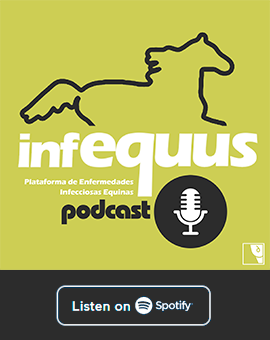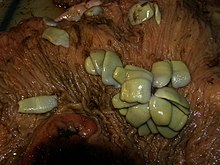Anoplocephala tapeworm
Etiology
Intestinal cestodes belonging to the family Anoplocephalidae. These cestodes have an unarmed head or scolex with four suckers. There are three species of Anoplocefalidae: Anoplocephala perfoliata, A. magna and A. mamillana. The most frequently associated with clinical disease is Anoplocephala perfoliata, usually located in the large intestine near the ileocecal valve.
Epidemiology
The cestodes of the family Anoplocephalidae have an indirect biological cycle. Oribatid mites (Galumma spp) are the intermediate hosts and they ingest the cestodes eggs that have been eliminated in the faeces of horses. The eggs contain the hexacanth oncosphere inside. The development of the oncosphere to cysticercoid (infective stage for the definitive host) takes place in the coelomic cavity of the oribatid mite. Horses become infected by ingesting the cysticercoid in pasture with oribatid mites. The prepatent period is 6 to 16 weeks. The prevalence of A. perfoliata is associated with the pasture stocking rates, the pasture type and the temperate climates.
Pathogeny
Adult A. perfoliata cestodes inhabit mainly the ileocecal valve; they can also be found in the cecum, terminal ileum and ventral colon. The suckers in the head cause ulceration and catarrhal enteritis due to its embedding to intestinal wall. These ulcers can be contaminated with food and intestinal microflora resulting in a perforation or an intestinal torsion and a peritonitis and death of the animal finally.
Clinical signs
Severity is directly proportional to parasite infection intesity. Clinical signs associated with A. perfoliata are recurring diarrhea, progressive weight loss and anaemia of chronic disease. A. perfoliata is associated to spasmodic colic and ileal impactation. More serious clinical signs would be: ileocecal colic, intussusception of ileum and / or cecum and perforation and / or caecal torsion.
Diagnosis
The most common technique for the diagnosis is coprologic examination for the visualization of the adult parasites eggs. The eggs are often “D” shaped, with a pyriform apparatus, which contains the hexacanth larva. Both simple flotation technique and the double-centrifugation (sedimentation followed by flotation) are used. However, both techniques are more time-consuming and they often lack sensitivity. Currently, serologic testing using scolex antigen and excretory/secretory antigens of A. perfoliata have been developed. The ELISA presents high sensitivity and specificity and correlates with infection intensity.
Treatment
There are few anthelmintic with cestocidal activity. The best therapy is the combination of praziquantel and ivermectin or moxidectin (broad-spectrum anthelmintics). There is disagreement regarding use of low dosage of pyrantel pamoate, which has demonstrated dislodgement of gravid segments, with retention of the scolex in the intestinal wall.
Prevention and control
There are two approaches to tapeworm control. The first is interval treatment every 6 months. Tapeworm infections are not associated with seasonality, but periods of prolonged grazing are important, so treatment at the end of such periods is rational. The second approach would be the shipment to the laboratory once a year of faeces samples or blood samples to get a tracking of the horses and the diagnosis of those infected. Other proposed measures would also be rotation of pastures, periodic removal of faeces from horses (not possible in communal pastures) and alternating grazing with other animal species such as cattle.
Public Health Considerations
Anoplocephala is not a zoonotic disease and it is not included in the notifiable diseases OIE list.
References
- Equine Infectious Diseases. 2014 Elsevier Inc. ISBN: 978-1-4557-0891-8


